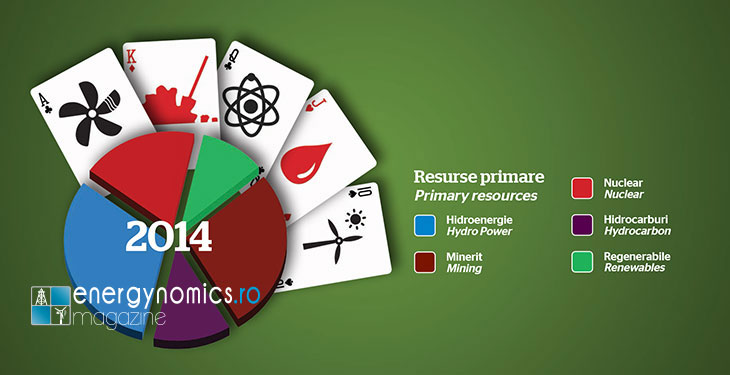On paper, Romania has electricity production capacities of over 22 thousand MW. For many years, no more than 10 thousand MW have ever been used simultaneously. Official estimates show that approximately 30% of production capacities have exceeded the lifespan of 40 years, and 25% already have 30 years of operation. Most of them are highly polluting and economically inefficient. Keeping these capacities unused requires costs reflected in the final bill of electricity users, as system services. For example, a thermal power plant which hasn’t been started for three years can receive significant amounts every year for staying idle.
There have been many forecasts of the introduction of new production capacities simultaneously with the reduction of the existing ones, but abandoning the new projects and authorities’ reluctance in liquidating certain old units maintains a situation of theoretical overcapacity at national level. The most difficult situation is in the thermal energy sector – about 80% of thermal power groups in Romania have been installed during 1970-1980, and currently they have long exceeded their normal lifespan.
The structure on types of resources used in electricity production shows that hydropower was the main contributor in 2014. It was however an atypical year, because in four of the previous five years (except for 2010), coal-based production had the greatest share. While in 2010 renewable energy did not matter, in 2014 wind, solar and biomass production exceeded 10% of the total. Annual production based on hydrocarbons varied from simple to double in the past five years, while nuclear accounted for 18-20% of the total.
Maintaining the balanced mix, a strategic goal
At first glance, the numbers show a balanced mix and good potential for the replacement of volatile resources (hydropower and renewable energy) – an essential factor for the security of the national energy system. Officials from the Ministry of Energy have clearly indicated that they planned to keep this mix balanced in the future. The decision is partly inconsistent with environmental targets (the pro-renewables option) and factual data (aging power plants), in conditions of a low affordability of consumers.
Still in insolvency, but in full process of reorganization, Hidroelectrica is a firm pillar of the future national energy mix. The leading position in electricity production does not seem to be seriously threatened for decades to come. Hydropower production is efficient in stabilizing the system. Hydropower production is extensive in good hydrological years and significant in poor hydrological years. Hydropower production is cheap, with all the burden of industrial water costs. Hydropower production makes money – RON 625mln profit in the first five months of 2015 and investment plans of EUR 1.3bn until 2020.
Risks could come from the pressure put by the regulator on revenues – most of the production goes in the basket reserved for household consumers, at minimum market prices. The large number of units distributed all over the country and the age of many units require significant investments. To finance them and in general to manage a giant with over 3,500 employees requires both solid and flexible management.
Listing the company on the stock exchange is one of the objectives mentioned by authorities, the new deadline announced by the Energy Ministry being 2017, with the condition of getting out of insolvency in 2016. Unlike Electrica’s case, attracting in the ownership structure of new partners is not mainly aimed at increasing liquidities – Hidroelectrica announced in April that it had EUR 200mln in its accounts. The main stake here is forcing the introduction of corporate governance and transparency which only the removal of political influence could promise.
Support for renewables decreases as they reach a learning curve
Renewables are considered the resource of the future and benefited from massive support to enter the Romanian energy mix. The unexpected reduction of support in 2014 slowed down the growth of the sector and authorities seem content with the share of green electricity in the production structure. Statements made by Minister Andrei Gerea suggest that public aid for renewable development could continue to decrease along with the maturity of technologies. The potential of large wind or solar farms seems exhausted in such circumstances. Investors are still waiting for details about the implementation of the feed-in-tariff system, which could boost not only the micro-production based on solar and wind energy, but also biomass power plants.
Increased production of green electricity coincided with increased exports in the context of a stagnant domestic consumption. There are voices accusing subsidies by the public for production bound for export, to the exclusive benefit of traders. The fact that the electricity price at producers has fallen in Romania as a result of entry into the market of renewables, which put under pressure all producers to make their activity efficient, is often ignored. The spectacular volatility of wind energy production is one of the problems of the energy system, but also a potential area to express technological and entrepreneurial innovation. A detailed analysis of subsidies for renewable energy and their indirect effects (distorting the production market, pressure on transmission networks, real impact on prices etc.) is yet to be achieved.
————————————-
The full version of this article can be read in printed edition of energynomics.ro Magazine, issued on December 2015.
In order to receive the next issue (March 2016) of energynomics.ro Magazine for free, we encourage you to write us at [email protected] to include you in our distribution list.

